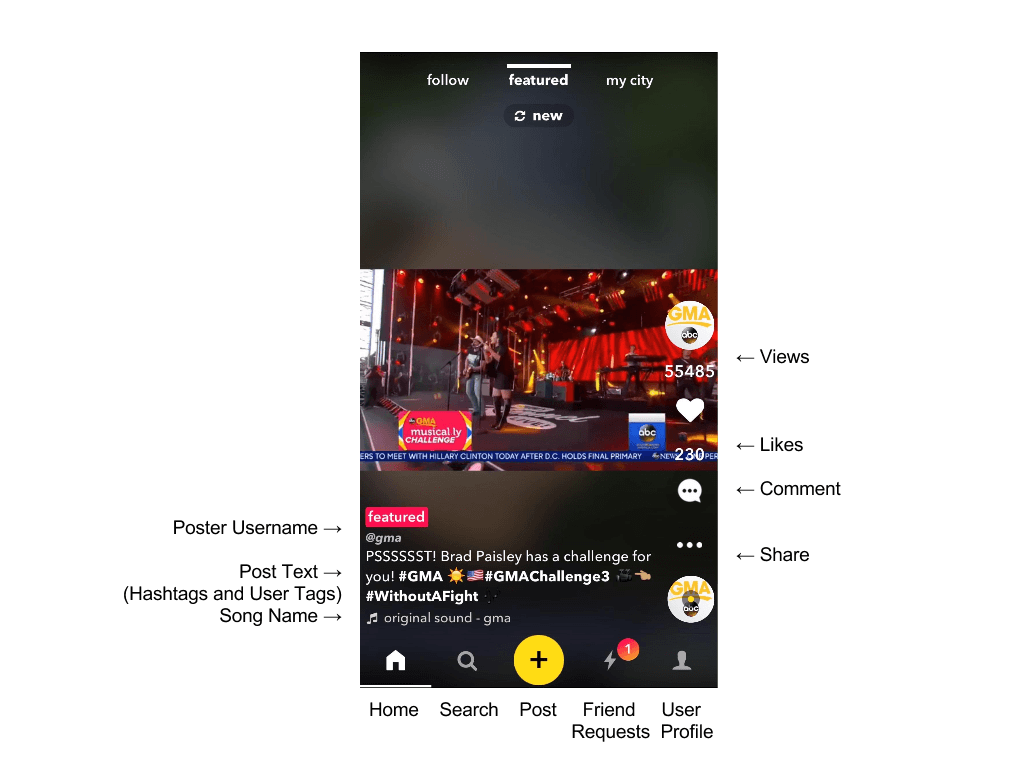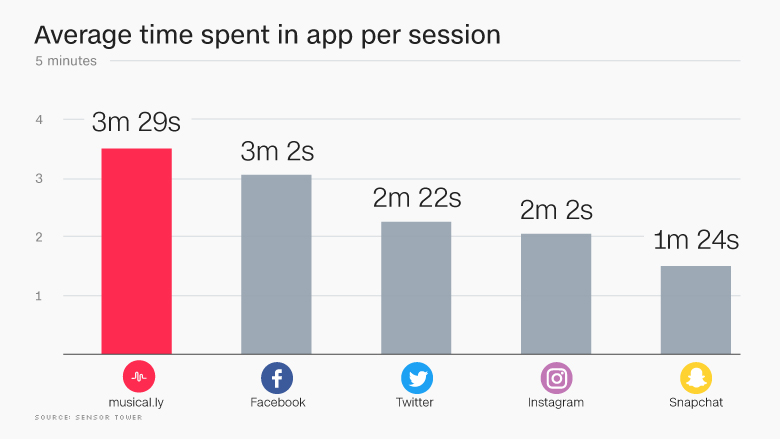musical.ly strikes the right chord – to the tune of 40M MAU

musica.ly was one of the hottest apps of 2015 and 2016 – and hasn't left the App Store Top 40 ever since. Are its 15-second videos a one-hit wonder, or are they here to stay?
In 2016, Twitter killed Vine just as standout live streaming app, Meerkat, was declared officially finished. Despite the deaths of these once-hot digital companies (R.I.P. Vessel), short-form clip creation is very much alive at musical.ly, the world’s “largest creative platform” and “instant lip sync” app turned social network. Shanghai-based musical.ly debuted in the App Store in 2014 and has been winning ever since. Today, with over 133 million registered users and 40 million MAU[1] – and an estimated $500 million valuation[2] – musical.ly is changing the way teens communicate with one another (roughly half of teens and preteens in the U.S. use the app[3]), while sending shockwaves through the music industry.
musical.ly’s momentum shows no signs of slowing as it creates value by giving users a suite of simple creative tools, sticky feedback mechanisms, and a powerful network for distribution. The app also creates value for music labels by offering coveted access to a large and targeted cohort of young people (64 percent of U.S. users are 13-24)[4].

People First
musical.ly gives people tools to create 15-second videos paired with songs. Users can share videos, engage, and discover content through an engaged and thriving community currently growing at a clip of 13 million new users each month[5]. What makes musical.ly so great? The product starts with people at its core. In 2015, the musical.ly team invested in what they call “community work”, talking to users of the app to find out ways to make it better, more useful and engaging – and came up with improved editing capabilities, a leaderboard, and “BFF” (Best Fan Forever) badges which borrow some of the best features of today’s most popular social sites.
“Musers” Hit the Big Time
People using musical.ly are not “users”; they are “musers” – and they are very loyal and increasingly obsessed with the platform. musical.ly rewards its musers – and keeps them coming back – by promoting and displaying “popular” videos within the app, helping them gain a greater following and increased viewership. In fact, musical.ly has already acted as a launchpad for its first “superstar”, 13 year-old Jason Sartorius, who boasts 11M fans and recently signed a contract with United Talent Agency[6]. musical.ly gives its musers the chance to express themselves in powerful and creative ways and, in some cases, the opportunity to hit celebrity status overnight.
Music Labels Love it, Too
musical.ly has also found ways to unlock value for the music industry. Musers engage in what some are calling the “secondary consumption[7]” of song clips, where primary consumption is streaming and downloads and secondary consumption is sampling or discovery of those songs through short-form video clips (like the ones on musical.ly). For some labels, song promotion on musical.ly has led to a direct increase in streams and big bumps in sales: Aaron Bogucki at music label Republic said that he saw an 11 percent increase in streams for one musical.ly promotion and a 182 percent boost in sales for another song, “Oh My Love”. Warner Music was the first label to sign a deal with musical.ly to allow its library of music to be licensed for the platform, demonstrating that the company is taking a much different and more collaborative approach with the industry than some of the popular music technologies that precede it (e.g., Napster, Pandora).
Capturing Value Through its Large Audience
musical.ly is working to quickly capture value from its fast-growing and engaged userbase. Users currently spend more time in the app per session than they do on Facebook, Twitter, Instagram, or Snapchat and 11 million new videos are shared on musical.ly each day[8].
In June 2016, musical.ly launched its first follow-on app, live.ly, a product focused on live streaming. Only 3 months after launch, live.ly was said to have amassed over 4.6 million MAU on iOS, surpassing an estimated 4.3 million MAU for Twitter’s live streaming app, Periscope. live.ly focuses more on interaction between people and immediate streaming as musical.ly has seen more recent growth in the app coming from “other kinds of videos”. musical.ly has already seen significant crossover between its core app and livel.y, which is currently testing a virtual gifts business (musical.ly investor Hans Tung points to Tencent’s $200 million market cap, with a meaningful revenue stream from virtual goods in online games and e-commerce).
musical.ly continues to experiment with ways to monetize its highly engaged “muserbase”, launching test campaigns with brands like Coca-Cola and Lionsgate. As ads are integrated into musical.ly’s product, will users remain engaged, or will the product feel too commercial? And, as musical.ly considers the long-term viability of its business, will the platform prove to be valuable not just to tween-targeting brands but to mainstream advertisers, as well?






Musical.ly has blown it out of the water in terms to user growth, and has done a spectacular job of riding the wave of their virality to launch new products and expand to paid advertising. How do you think they should combat the tendency of “fadishness” among teen apps and keep users engaged on the platform as both they and it grow up. For example, Yik Yak had similar growth metrics in its first year, and took advantage of network effects and virality to launch massive marketing campaigns. But less than 2 years later, they’ve announced they are laying off most of their staff. How can Musical.ly avoid this fate?
Musical.ly’s growth over the past couple years has been quite impressive. I agree that they’ve done a great job of not just creating a simple product that puts music over any video, but rather built in tons of social features that makes it so sticky. My only concern with apps like this is that there are so many “hot” apps that were huge and dead in the water now. Advertising is a popular monetization method for social media and it sounds like they will take that approach. However, do you think they will be able to keep the lights on and pay all the licensing fees the music publishers will ask for as they become more popular? I’m worried a path to profitability will be difficult for them.
Libby, awesome post – I realized that musical.ly had experienced serious growth but not at such a rapid clip. I am concerned less about the “fad” aspect of the app/user experience given the increasing popularity of short-form and non-scripted content, particularly in China, which it can always fall back on given that its based in Shanghai. My concern is whether other social media players, in particular YouTube and Snapchat, begin to develop a mobile UX that copies many of musical.ly’s features. With their massive scale, do you think there is a risk that musical.ly users begin to create similar content on those platforms? Alternatively, musical.ly seems like it could be a great acquisition target for a competitor such as YouTube (a la Facebook/Instagram).
Thank you so much for sharing this. This is super interesting!! I wonder, same as the question that Ellen and Nurpur mentioned but in a broader sense, that what are some of the key elements for social media platform to stick around and not decline or disappear in a span of few years? What is their innovation strategy after launch? As most of the time, only fine-tuning on some of the app function could be done. Or they simply do portfolio strategy where they just fade out the old ones, and continue launching new social apps that might suit the next wave of consumer appetite?
Great company to focus on and definitely one that has raised lots of eyebrows of folks at they have grown MAU so quickly. I have sisters that are 10 and 11, and one thing that amazed me last time I was home was that they were watching collections of musical.ly on Youtube. It made me think about the reach of the app and realized that their audience is even larger than just the people who consume the content directly in the app. I wonder what potential this offers the company to share its content with other partners to scale even more quickly than other apps do and to bring in revenue more quickly by sharing ad revenue with sites such as YouTube.